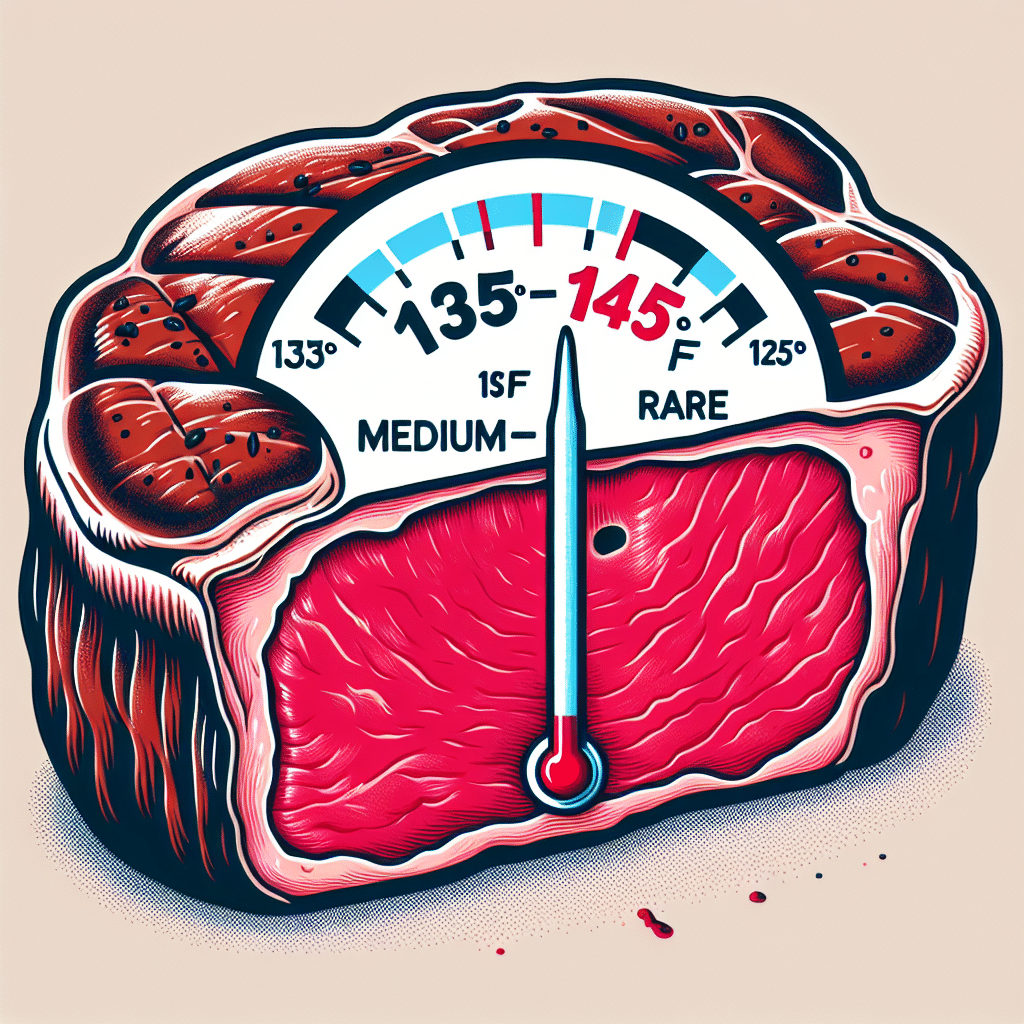Understanding Medium-Rare Meat: The Ideal Temperature
When it comes to cooking meat, temperature is the key to achieving the perfect doneness. For medium-rare steak specifically, the ideal internal temperature ranges from 130°F to 135°F (54°C to 57°C). At this temperature, the meat remains juicy, tender, and flavorful, boasting a pink center that is both appealing and enjoyable. Cooking meat to this specific temperature ensures that it retains its natural moisture and provides a delightful eating experience, making it a popular choice among steak enthusiasts. It’s also essential to use a reliable meat thermometer to accurately gauge this temperature, as improper cooking can lead to food safety concerns.
Why Temperature Matters in Cooking Meat
Temperature plays a vital role in both the safety and quality of meat. When you cook meat to its appropriate internal temperature, you ensure that harmful bacteria are killed, therefore, preventing foodborne illnesses. Additionally, temperature affects the meat’s texture and flavor. For consumers, understanding the distinction between various temperature zones—rare, medium, and well-done—can elevate their dining experience significantly.
The Science Behind Medium-Rare Meat
Medium-rare meat is often considered the gold standard in steak cooking. Cooking steak to a medium-rare level allows you to enjoy the natural juices and flavors of the meat without the dryness that often accompanies overcooked options. This section will delve into the science behind achieving a perfect medium-rare steak.
What Happens at Medium-Rare Temperature?
When meat is cooked to a medium-rare temperature of 130°F to 135°F, several chemical reactions occur. The proteins in the meat begin to denature, and the collagen breaks down into gelatin, resulting in a tender and flavorful cut. The fat within the meat melts, basting the surrounding meat, which ensures moistness. This melting process gives medium-rare meat its characteristic juiciness and rich flavor profiles.
Visual Indicators of Medium-Rare Meat
In addition to using a thermometer, there are visual cues for identifying medium-rare meat. The meat will have a warm, red center surrounded by a pinkish ring. The exterior will have a nice sear, which adds a rich flavor through the Maillard reaction—a complex process where sugars and amino acids react under heat, resulting in browning and delicious taste.
Meat Types and Their Ideal Medium-Rare Temperatures
Different types of meat can be cooked to medium-rare, but knowing the specific temperatures for each type enhances your cooking finesse. Here are some common meats and their ideal conditions for medium-rare preparation:
Steaks
Steak, primarily beef, is widely recognized for its versatility in cooking methods. To achieve medium-rare beef steak:
- Target internal temperature: 130°F to 135°F (54°C to 57°C)
- Steaks suitable: Ribeye, Sirloin, Filet Mignon, T-bone
Lamb
Similar to beef, lamb can also be enjoyed at medium-rare but requires careful monitoring for flavor and texture:
- Target internal temperature: 130°F to 135°F (54°C to 57°C)
- Recommended cuts: Lamb chops, Rack of lamb
Pork
Traditionally, pork is recommended to be cooked to 145°F for safety. However, shoulder cuts can often be enjoyed at:
- Target internal temperature: 145°F (63°C)
- Applicable cuts: Pork tenderloin, Bone-in pork chops (cooked medium to medium-rare)
Fish
Certain fish like tuna or salmon can also be served at a medium-rare level:
- Target internal temperature: 125°F to 130°F (52°C to 54°C)
- Common examples: Ahi tuna, salmon steaks
How to Achieve Medium-Rare Meat
Achieving the perfect medium-rare meat requires a combination of technique, timing, and equipment. Here are methods you can utilize:
Grilling
Grilling is among the most popular methods for cooking meat. To achieve a medium-rare finish:
- Preheat your grill to medium-high.
- Sear the meat for about 4-5 minutes on each side, then monitor internal temperature closely.
Pan-Searing
Pan-searing with a heavy bottom skillet can produce delightful results. Follow these steps:
- Heat oil over medium-high heat and add the seasoned meat.
- Sear for approximately 4-5 minutes on one side, then flip and cook for another 3-4 minutes.
Sous Vide
The sous vide method allows for precise temperature control. To prepare medium-rare sous vide:
- Seal meat in a vacuum bag with seasonings.
- Cook at 130°F for 1 to 4 hours.
- Sear briefly in a hot skillet for texture.
Oven Roasting
Oven roasting can also yield a perfectly medium-rare result, particularly for larger cuts of meat:
- Preheat the oven to 375°F.
- Roast until the internal temperature reaches 130°F, then rest meat before slicing.
Common Mistakes to Avoid When Cooking Medium-Rare Meat
Even experienced cooks can make simple mistakes that lead to dryness or overcooking. Here are a few things to avoid:
- Not using a meat thermometer can lead to inaccurate doneness levels.
- Cutting into the meat too early while resting removes essential juices.
- Overcrowding the cooking surface inhibits proper cooking and browning.
Frequently Asked Questions (FAQs)
1. Is medium-rare meat safe to eat?
Yes, medium-rare meat is generally safe to eat if sourced from reputable suppliers. However, it is essential to ensure proper handling and cooking practices to mitigate any foodborne illness risk.
2. Can I use a meat thermometer to check for medium-rare doneness?
Yes, a meat thermometer is one of the most reliable ways to check for doneness. Insert it into the thickest part of the meat, avoiding any bones.
3. What’s the best way to rest meat after cooking?
Allow the meat to rest for at least 5 to 10 minutes after cooking. This resting period helps redistribute the juices, ensuring a moist and flavorful final product.
4. What’s the difference between medium and medium-rare meat?
Medium meat is cooked to an internal temperature of 140°F to 145°F (60°C to 63°C), resulting in a firmer texture and less pink than medium-rare.
5. Can you cook meat at lower temperatures for longer?
Yes, cooking meat at lower temperatures (like sous vide) can yield juicy and perfectly cooked results. Just ensure you’re aware of the specific temperature ranges for safety and quality.
Conclusion
Achieving the perfect medium-rare temperature for your meat is both an art and a science. By understanding the right internal temperatures, cooking methods, and common pitfalls, you can ensure a delicious result every time. Whether grilling a steak or pan-searing a pork chop, mastering medium-rare doneness transforms your culinary experience into an enjoyable journey of flavor and texture.

